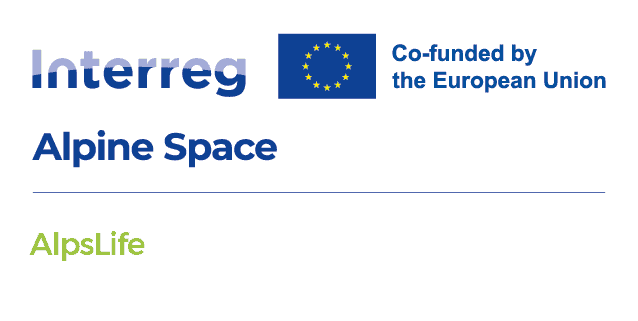
Overview
Actions to conserve and restore biodiversity are often incoherent and not planned at the Alpine scale, preventing effective conservation actions on a transnational level. AlpsLife establishes a common framework to ensure interoperability from different datasets and their monitoring scheme, facilitating cross-national strategies. Building up on an innovative approach on data-sharing coordination, the project assesses Alpine biodiversity trends, creating a common understanding of biodiversity processes to ensure consistent conservation decisions across borders.
Factsheet
- 2021 – 2027
- Climate resilient and green Alpine region
- SO 1.2 - Enhancing protection and preservation of nature, biodiversity and green infrastructure, including in urban areas, and reducing all forms of pollution
-
- AG6 Natural resources
- AG7 Ecological connectivity
- 09/2024
- 08/2027
- 2.916.176 EUR
- 2.082.132 EUR
Partners
- 46.494530211.3472734
- 47.26793911.378443180594596
- 45.5638749999999965.925742711213934
- 47.23837689.5968524
- 41.81583854999999512.467753508920092
- 47.633735913.0006247
- 46.368757314.1188705
- 47.593905114.49396123591879
- 45.91829076.1347254442053
- 45.02936637.6549305
- 46.6997293510.096186373340856
- 46.467883610.3750461




























Outcomes
-
Comprehensive Alpine Biodiversity Data Hub and indicators
Database of existing spatial variables (maps) integrating with high-quality in-situ data gathered in A2.1 & A1.1. Biodiversity assessment toolkit enhanced by harnessing insights from previous AS projects and expanding internationally established surrogate indicators to assess biodiversity changes and patterns, providing valuable resources for pan-Alpine assessments. AlpsLife provides downloadable maps on the ATLAS platform (https://www.atlas.alpconv.org/), ensuring long-term data accessibility. -
Maps of data gaps in monitoring schemes and ecological indicators for key taxa in the Alps
Maps based on a review of monitoring schemes (MSs) in use and existing data in the Alps. Applying European ecological indices or indicators for aquatic and terrestrial ecosystems, special emphasis is given to species listed in the Birds and Habitats Directives, rare species, indicator species, or specific taxonomic groups (birds and butterflies). Maps are accessible by https://www.atlas.alpconv.org/ coherently with WP1 activities. Obs.: Biodiversa+ (FR), GMBA (CH), UniTo (IT). -
Guidelines for creating interoperable and comparable ecological data for EUSALP Project Partners and Observers
Summary and description on how to create compliant data based on reviewing the compatibility and interoperability of existing MSs for aquatic and terrestrial ecosystems in EUSALP. The maintenance of compliant spatially explicit data enables researchers and decision-makers to explore the dataset and to use indicators for future actions, even in areas where data on ecological indicators, species trends and monitoring schemes are not readily (or not yet) available. -
Network of Pilot monitoring areas for an early warning system of Alpine biodiversity evolution based on standardised protocol and agreed species indicators
Permanent monitoring on species and habitat types with 6 APAs implementing the findings of the project (D2.3.1, A2.4, D3.4.1, A3.3, A3.4) in a realistic scenario (permanent staff) and based on commonly developed indicators and agreed protocol on selected species and habitats (N2000) comp. alien species. Monitoring sites comprise APAs & contribute to biodiv. monitoring & the eval. of MM on EU & biogeographical level (EU-BDS 2030, EU NRL, GBF). Interaction with AlpConv & EUSALP AG6 & AG7 (A4.4). -
Tested governance framework for collaborative alpine biodiversity monitoring and indicator streamlining
A practically tested governance structure showcases how various administrative levels, and data collectors, can collaborate (A4.3) to contribute to streamlining biodiversity indicators and to secure monitoring activities on the long-run, that pay into biodiversity targets of the Alps. Part of the Tool Kit (D4.3.1) is a proposal for a harmonized “modus operandi” between EUSALP and AlpConv on how to establish the AlpsLifeCoreGroup as a permanent working group for monitoring activities in the Alps.
Gallery
Project calendar



